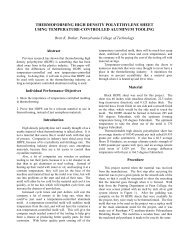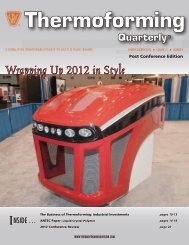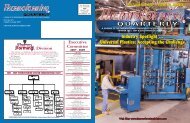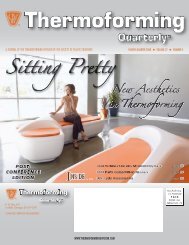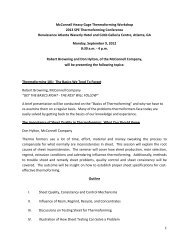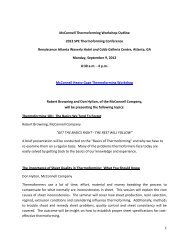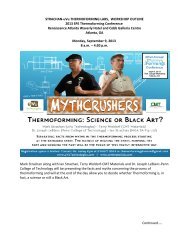Third Quarter - SPE Thermoforming Division
Third Quarter - SPE Thermoforming Division
Third Quarter - SPE Thermoforming Division
You also want an ePaper? Increase the reach of your titles
YUMPU automatically turns print PDFs into web optimized ePapers that Google loves.
Figure 1. Schematic of Caliper Control of ± 1% for DPET.<br />
Competitive Product<br />
seen in Figure 5 shown on page 18.<br />
On running the cost models we see<br />
that there is a cost savings of $4,585<br />
when using DPET vs. RPET and<br />
savings of $4,551 when comparing<br />
DPET to APET on the GN contact<br />
heat machines. This implies an<br />
approximate 12% reduction in the<br />
cost of production. Comparing the<br />
contact heat machine with the radiant<br />
machine, there is a total savings of<br />
about 13%. A cost savings of $10,240<br />
is achieved when running DPET on<br />
the GN machines vs. APET on radiant<br />
machine, and a savings of $10,200<br />
when compared to RPET on a radiant<br />
machine. A total savings of 24% is<br />
achieved as seen in Figure 6 on page<br />
18.<br />
Cost Comparison APET, RPET & DPET<br />
$ 4,581<br />
12.19%<br />
ENERGY CONSUMPTION<br />
The GN DX machines use 6.8 KWs<br />
to run. In the model, radiant units use<br />
70 KWs to run (based on survey of<br />
machines comparable to GN 30" x<br />
21" forming area). Using the models<br />
we find the following comparisons<br />
shown on page 18.<br />
In summary, the use of GN’s<br />
machine and OCTAL’s DPET<br />
was found to lower the amount of<br />
energy used in the thermoforming<br />
process. Thus, the combination of<br />
these two new technologies resulted<br />
in significant savings potential for<br />
the thermoformers in both production<br />
costs and energy consumption. x<br />
See<br />
Figure 4,<br />
Figure 5,<br />
Figure 6,<br />
Table 2,<br />
Figure 3. Tooling Cost GN Vs. Radiant.<br />
Radiant heat machines produce<br />
an average of 6200kg (13640 lbs.)<br />
of scrap whereas the contact heat<br />
machine running DPET produces<br />
only 2,299kg (5058 lbs.) of scrap.<br />
This combination produces about 63%<br />
less scrap/waste and reduces cost of<br />
electricity by 78% when compared to<br />
radiant machines. This will reduce the<br />
cost of raw materials to about 16% as<br />
Figure 7,<br />
& Figure 8<br />
on the<br />
following pages.<br />
(continued on next page)<br />
<strong>Thermoforming</strong> QUArTerLY 17



